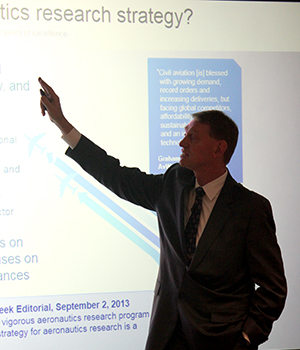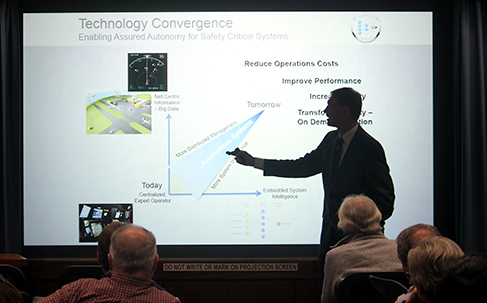NASA’s Vision for Transformative Aeronautics
 Within a single lifetime, the distance that humans could fly grew exponentially—from a few hundred feet with the Wright Flyer to nearly 240,000 miles with Apollo 11. In the early 1950s, the jet age shifted air travel from curiosity to commonplace, with commercial flight connecting previously far-flung corners of the world.
Within a single lifetime, the distance that humans could fly grew exponentially—from a few hundred feet with the Wright Flyer to nearly 240,000 miles with Apollo 11. In the early 1950s, the jet age shifted air travel from curiosity to commonplace, with commercial flight connecting previously far-flung corners of the world.
Today, we are again on the cusp of many exciting challenges in transformative aeronautics, according to NASA Director of Airspace Operations and Safety John Cavolowsky, the latest speaker in Volpe’s Reimagining Transportation speaker series.
“Being able to define the concept space and the way in which we drive technology is, to me, surprisingly, the biggest challenge that we’ve had to address,” Cavolowsky said. “It’s a field that is evolving so quickly—what is the state of the art right now and how fast can we expect it to go?”
The Three Big Megadrivers
Coming changes in aeronautics will be largely dictated by three megadrivers: demand for mobility, sustainability, and technological revolutions, Cavolowsky said.
First, new pockets of urban, middle-class populations will have more expendable income, spurring more global demand for air travel.
“Air transportation continues to be a critical global capability,” Cavolowsky said. “An amazing statistic from the United Nations is that urbanization is occurring at a rate of seven Chicagoes a year, globally.”
With more intense population concentration, the need to conduct business from those concentrated areas will spur accelerating demand for high-speed transportation, Cavolowsky said.
Climate change is the next megadriver in transformative aeronautics. Global demand for air travel must be met with new technologies that reduce emissions, Cavolowsky said.
The third megadriver—technological advances and standards—has been sparked by players outside the aviation sector, particularly in the automotive industry, and may bring on-demand aviation services through unmanned aerial systems (UAS) to a wider audience than ever before.

Unmanned Aerial Systems: A Trillion-Dollar Industry in Waiting
Unmanned aerial systems are not yet regularly bringing us packages, or inspecting our infrastructure and agricultural crops, but that day may not be far off. NASA will be a key player in making real the trillion-dollar potential of the UAS industry, Cavolowsky said.
“We’re looking to provide an operational system where individual operators of these vehicles can subscribe to provide a proposed flight, to have that flight managed within a safe constraint to perform their business operations, whether public service or otherwise,” Cavolowsky said. “We want to look to do that as early as possible.”
However, Cavolowsky emphasized a key point: “It has to be done safely,” he said.
NASA is developing a traffic management system to allow UAS operations within five years. Traffic management for UAS will not look like traffic management for commercial aviation. Instead of rooms where human controllers monitor airspace, UAS will be cloud-based with virtual perimeters based on the proposed path an aircraft will fly. By 2019, NASA expects a UAS traffic management prototype that will allow unmanned aircraft to fly even in dense urban areas.
Finding Inspiration Beyond Aviation
As aviation over the past century has made the world smaller, it has also made it more interconnected. When ideas and perspectives mingle, better outcomes happen. That point of view is the lodestar for transformative aeronautics in the 21st century, as the aviation sector seeks inspiration from an array of partners working to make transportation safer and more efficient.
“What we need to do from an aviation side, I think, is to really connect in with the broader community, the ground automation capabilities that are being driven by our more traditional automobile industry, and being able to look to them for standards,” Cavolowsky said. “They’re developing standards for autonomous operations right now. How do we take advantage of that to leverage what they’re learning?”
